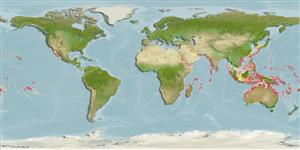>
Gobiiformes (Gobies) >
Gobiidae (Gobies) > Gobiinae
Etymology: Eviota: No etymology given, suggested by Christopher Scharpt: from Latin 'eu' for 'true' and 'iota' for anything very small, in combination 'truly very small' referring to it as being the smallest vertebrate at the time it has benn described by Jenkins (thus, making the suggestion by Scharpt plausible.
More on authors: Lachner & Karnella.
Environment: milieu / climate zone / depth range / distribution range
Ökologie
seewasser; brackwasser riff-verbunden. Tropical
Indian Ocean.
Size / Gewicht / Alter
Maturity: Lm ? range ? - ? cm
Max length : 1.9 cm SL Männchen/unbestimmt; (Ref. 116739)
Inhabits dead algal-covered reef in 3-15 m (Ref. 90102). Reported to feed primarily on harpacticoid copepods (49.5% - 100% of the gut contents) and they consume an average of 249 copepods per square meter of reef surface (Ref. 116739).
Life cycle and mating behavior
Geschlechtsreife | Fortpflanzung | Ablaichen | Eier | Fecundity | Larven
Tornabene, L., D.W. Greenfield and M.V. Erdmann, 2021. A review of the Eviota zebrina complex, with descriptions of four new species (Teleostei, Gobiidae). ZooKeys 1057:149-184. (Ref. 126577)
IUCN Rote Liste Status (Ref. 130435: Version 2024-2)
Bedrohung für Menschen
Harmless
Nutzung durch Menschen
Tools
Zusatzinformationen
Download XML
Internet Quellen
Estimates based on models
Preferred temperature (Ref.
123201): 24.4 - 29.3, mean 28.3 °C (based on 2876 cells).
Phylogenetic diversity index (Ref.
82804): PD
50 = 0.5000 [Uniqueness, from 0.5 = low to 2.0 = high].
Bayesian length-weight: a=0.00692 (0.00284 - 0.01683), b=3.10 (2.92 - 3.28), in cm total length, based on LWR estimates for this Genus-body shape (Ref.
93245).
Trophic level (Ref.
69278): 3.0 ±0.3 se; based on size and trophs of closest relatives
Widerstandsfähigkeit (Ref.
120179): hoch, Verdopplung der Population dauert weniger als 15 Monate. (Preliminary K or Fecundity.).
Fishing Vulnerability (Ref.
59153): Low vulnerability (10 of 100).
Nutrients (Ref.
124155): Calcium = 404 [167, 1,168] mg/100g; Iron = 1.54 [0.66, 3.46] mg/100g; Protein = 17.6 [15.5, 19.4] %; Omega3 = 0.106 [0.036, 0.297] g/100g; Selenium = 33.2 [9.7, 98.3] μg/100g; VitaminA = 123 [24, 593] μg/100g; Zinc = 4.31 [2.36, 7.23] mg/100g (wet weight);
